Brief

Executive Summary
- The development of the global green economy is accelerating as Covid-19 has reinforced actions already underway. Southeast Asia has not kept pace with other regions and now faces an inflection point. Yet, the good news is there is considerable untapped potential for the region’s green economy.
- Developing Southeast Asia’s green economy could provide up to $1 trillion in annual economic opportunities by 2030. Revenue pools from new growth sectors and estimated cost savings from efficiencies offer pathways to competitive advantage while advancing sustainability and society’s welfare.
- Businesses should be bold in leading the green transformation or risk playing catch-up.
The race is heating up—and the prize is material. Globally, countries are prioritizing sustainability investments as concerns about climate change and the resulting transition to a green economy gather speed and urgency. Economies around the world have passed major stimulus programs to address the Covid-19 pandemic and promote “build back better” initiatives. Such spending is accelerating the push toward green, sustainable industries. But in this race, Southeast Asia has yet to take much tangible and collective action.
The European Union has dedicated roughly $0.6 trillion from its recovery fund and 2021 to 2027 budgets to sustainable investments and green industries. This comes in addition to parallel country-level stimulus packages from France to Germany to Spain. Across the Atlantic, the new administration in the US plans about $2 trillion in investments in clean energy, infrastructure and automobile innovation over the next four years.
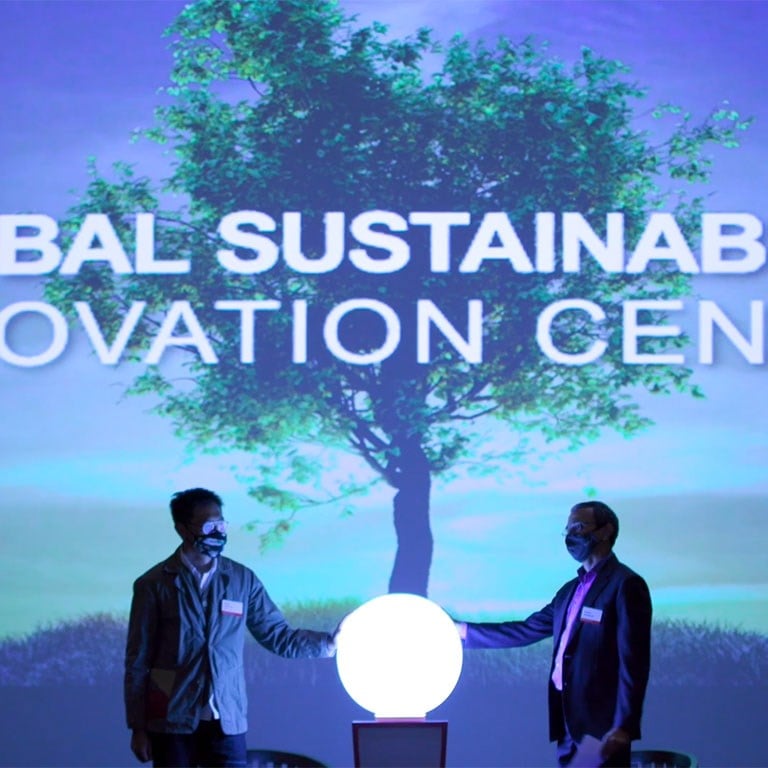
Southeast Asia's Green Economy: A Trillion-Dollar Opportunity
Bain’s Global Sustainability Innovation Center launches in Singapore to support organizations in accelerating economic growth while making the planet a better place.
In Asia, China is implementing a “New Infrastructure” stimulus to boost green growth. In addition to the $2.6 trillion in investments it made in renewable energy from 2010 to 2019, China has unveiled an amibitious five-year economic plan in 2020 that prioritizes innovation and technology in its sustainability initiatives.
All told, economies globally have committed to spend more than $3 trillion in 2020 to “build back better” and to stimulate green industries.
Yet Southeast Asia has been slow to act, despite its significant environmental responsibility for the world’s biodiversity (see Figure 1). No ASEAN nations figure among the top 40 in the rankings for attaining Sustainable Development Goals (SDGs). The region also experiences increasing environmental stress, including rising emissions and diminishing resources.
Southeast Asia has potential for big impact on environmental issues if promoting sustainability becomes a priority

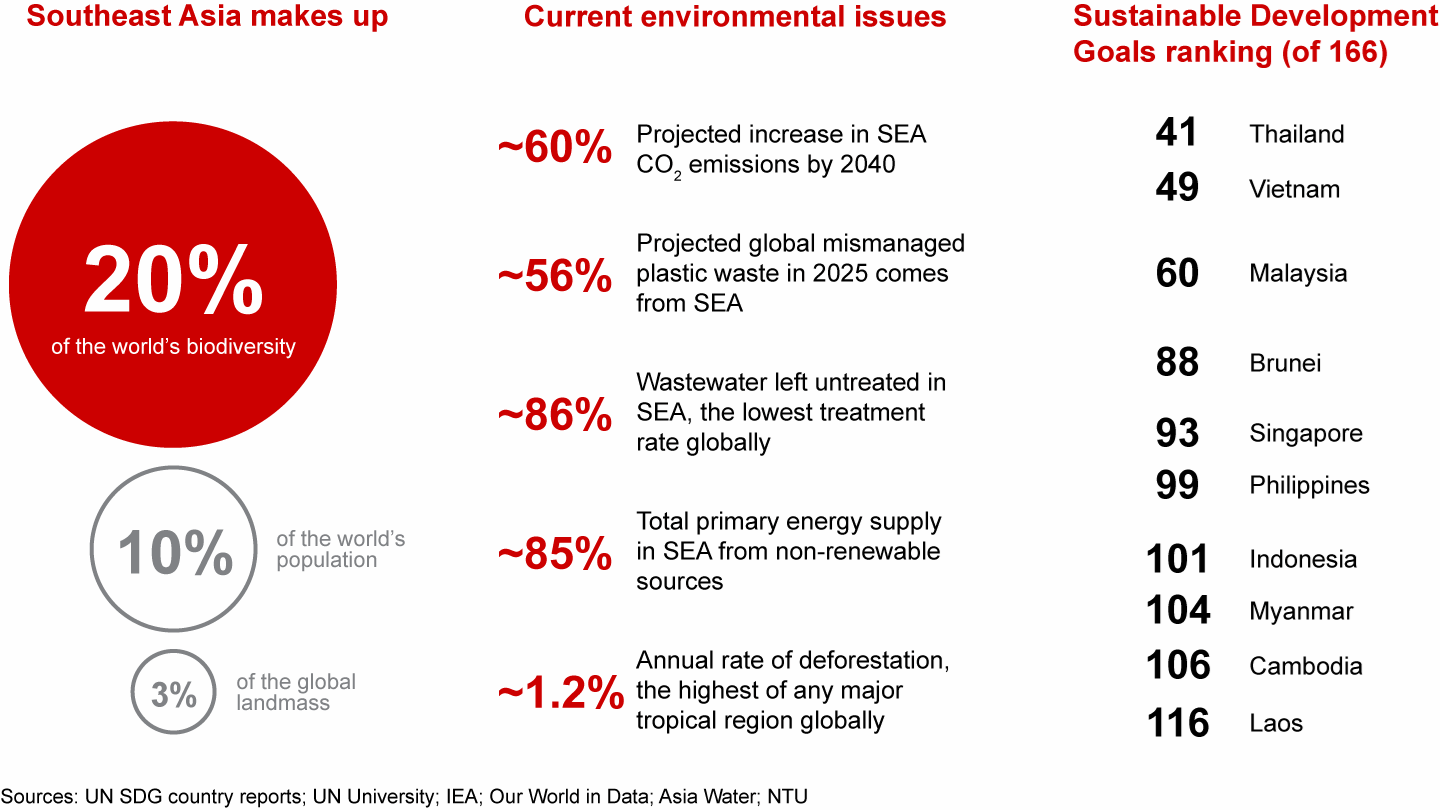
Unless addressed, this inaction presents a real threat to Southeast Asia’s global competitiveness in the decade ahead. Investors increasingly favor companies with better sustainability stewardship, while governments are considering taxes on imports from countries with high carbon footprints. Meanwhile, consumers are demanding sustainable products from the brands they support.
This report focuses on the size of the prize from the move to a greener economy by looking at the environmental aspects of sustainability as the primary dimension. Building the green economy is a multifaceted prize. Adopting green practices will meet the region’s wider environmental, social and governance (ESG) ambitions and in turn deliver societal benefits—ends in themselves that also underpin increased growth. In addition, the shift toward a green economy in material industries could offer multiplier effects to the rest of the economy in Southeast Asia.
Up and running—and ready to leap
After a slow start, Southeast Asia’s governments, corporations and investors are waking up to the economic and societal potentials of the green economy, due in equal parts to need and opportunity (see Figure 2).
Southeast Asia is accelerating its sustainability efforts

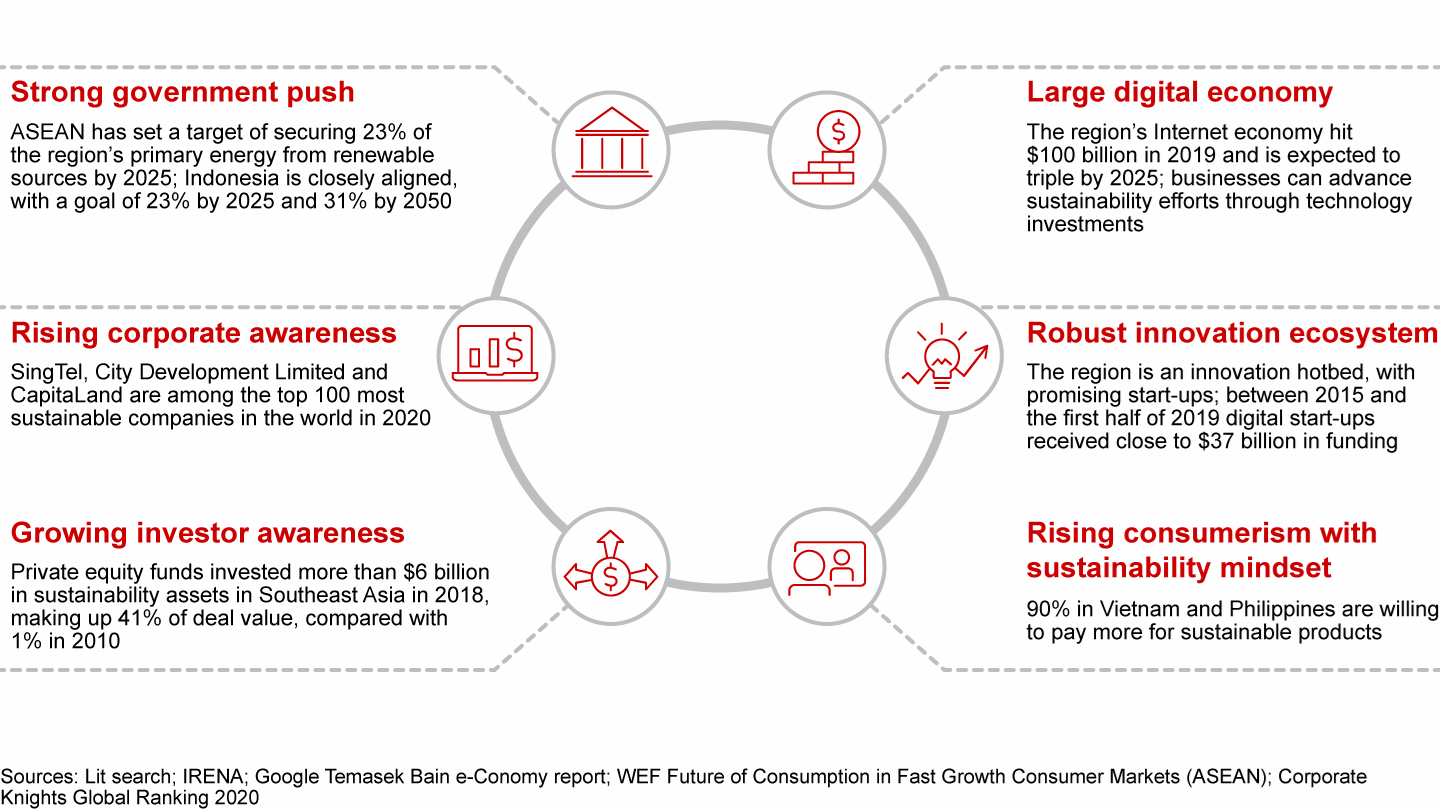
Many sectors are facing inflection points. The region has traditionally relied on coal plants to meet a large percentage of new electricity generation capacity, but international bank financing is waning for the construction of additional plants. Expansion of palm oil production is meeting resistance both locally and globally. Consumers in cities and frontline communities across the region are pushing back on plastic waste and other environmental concerns. And the Covid-19 pandemic has exposed gaps in current systems, disrupting supply chains and compromising food security at the peak of lockdown periods.
These changes are prompting an ongoing discussion of how to innovate and create advantage with a green mindset. The focus on post-pandemic recovery and job creation in certain sectors within each country further raises the stakes for governments—together with companies—to reimagine growth and adopt a new perspective on sustainability.
The challenges to change are still considerable for many economic sectors; however, Southeast Asia has proven that it can transform quickly when needed. For example, the region was not an early mover in digital transformation but accomplished that transition at an impressive pace.
A focused transition to a green economy offers Southeast Asian governments and businesses the chance to disrupt inefficient paradigms and pursue transformation.
- Where excessive resource extraction and energy consumption followed by waste mismanagement were the norm, there are opportunities to grow with decarbonization and electrification, responsible consumption and embedded circularity.
- Where agricultural growth has typically been inefficient and wasteful, Southeast Asia will be able to increase production in a regenerative and conscious manner that will make nutrition widely accessible.
- As industrial activity in Southeast Asia expands due to geopolitical shifts, manufacturing processes can be reimagined and supply chains connected and made transparent with full traceability to help ensure low carbon footprints.
- As cities grew in the 20th century, so did traffic congestion and pollution. Today, the way is clear to build affordable green homes in satellite settlements connected by green public transportation.
- While sustainable initiatives have struggled for financing and carbon-offset revenues have gone to waste, Southeast Asia can take the lead in green financing and be a home for a liquid carbon market where incentives to reduce emissions can be part of the prescription.
The consequences of rapid growth have always included burdens and inefficiencies, but advances in sustainability make it possible to leapfrog past those problems. Southeast Asia now has a significant and lucrative opportunity to become a global leader in these areas (see Figure 3).
Southeast Asia has an opportunity for massive sustainability transformation

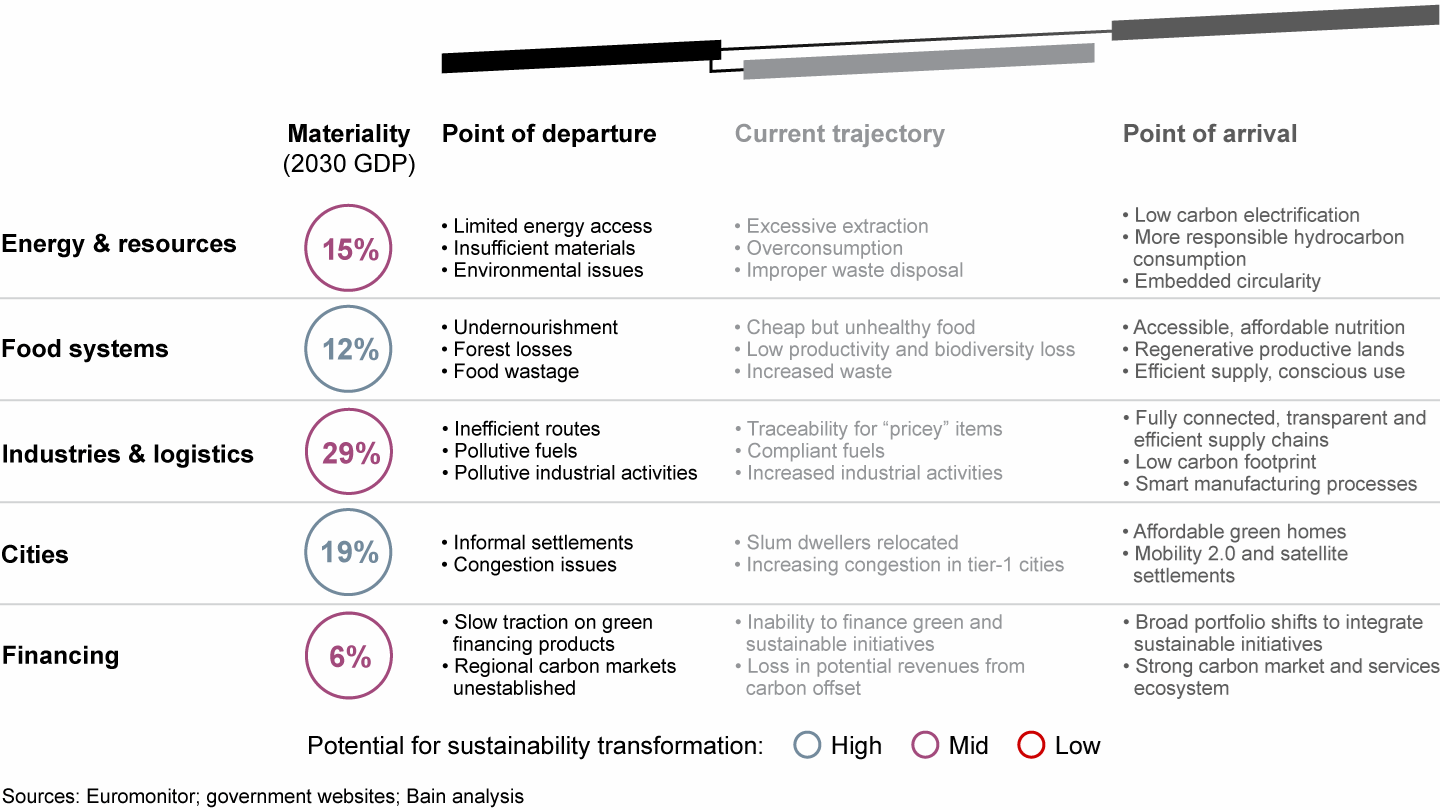
A prize worth playing for
Southeast Asia’s transformation toward a greener economy offers an economic advantage amounting to $1 trillion in annual economic opportunities by 2030 (see Figure 4). This includes value from the emergence or growth of new products and sectors arising from sustainable production and consumption, as well as savings from resource efficiencies of using less to produce more. The region also has the potential to lead in several pathways that present opportunities to export innovative products, expand to new services and capture a larger share of the global market.
Southeast Asian economies could experience up to $1 trillion in annual economic opportunities by 2030

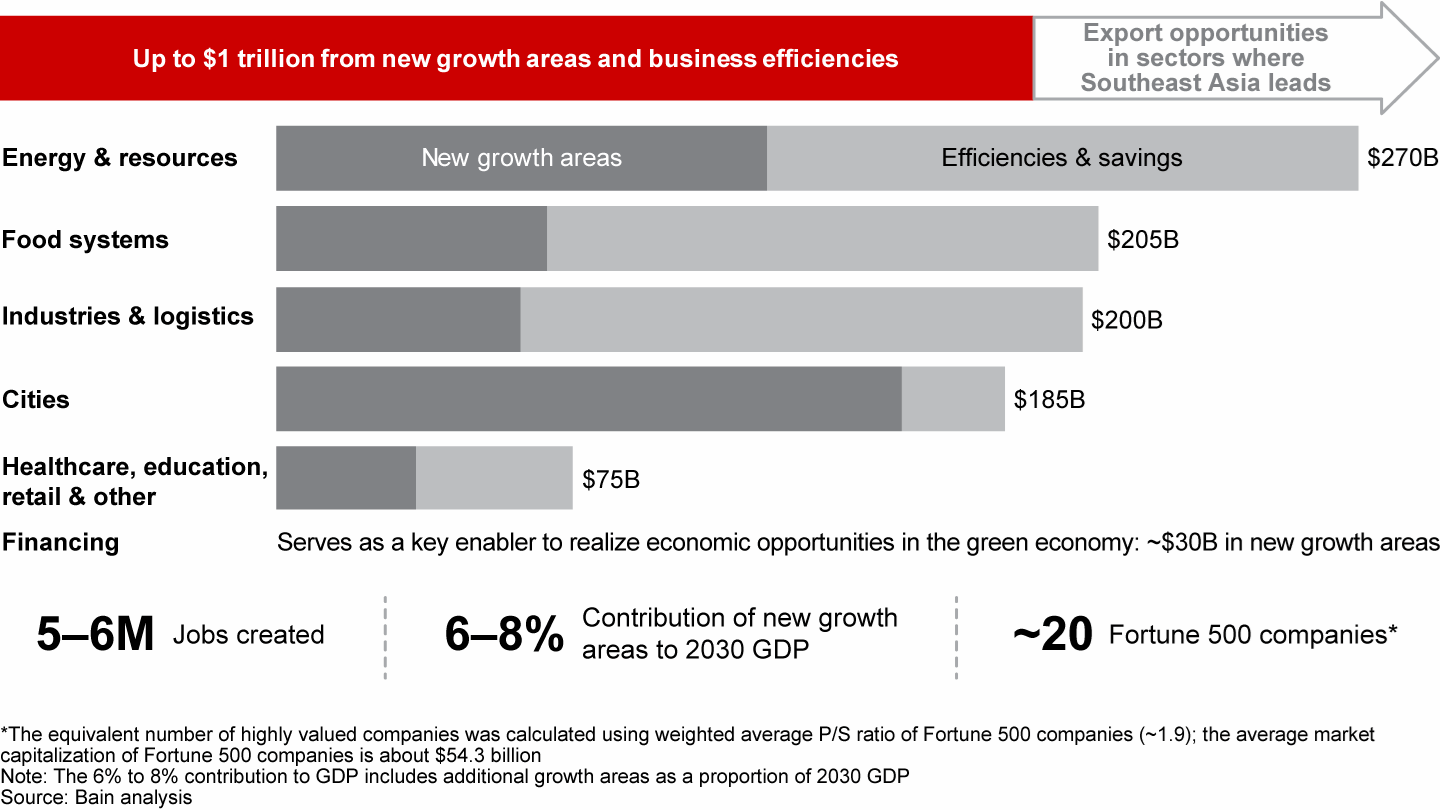
To secure this immense prize, it is crucial that all parties play their part. Governments must push boundaries and set the right policy directions for economies to recover sustainably. Businesses must commit to investing for the future, and consumers must push change through sustainable consumption.
Multiple pathways to full potential
Southeast Asia has complementary sets of pathways across industries that can unlock the trillion-dollar potential of the green economy. One set would focus on innovating and exporting new solutions to boost the region’s competitive edge. Another would concentrate on building new businesses and solutions to address the region’s most urgent needs. The last would accelerate the adoption of solutions to set Southeast Asia’s green economy flywheel in motion. Together, they offer areas where Southeast Asia can achieve its full potential (see Figure 5).
Southeast Asia has many pathways to unlock its green economy full potential

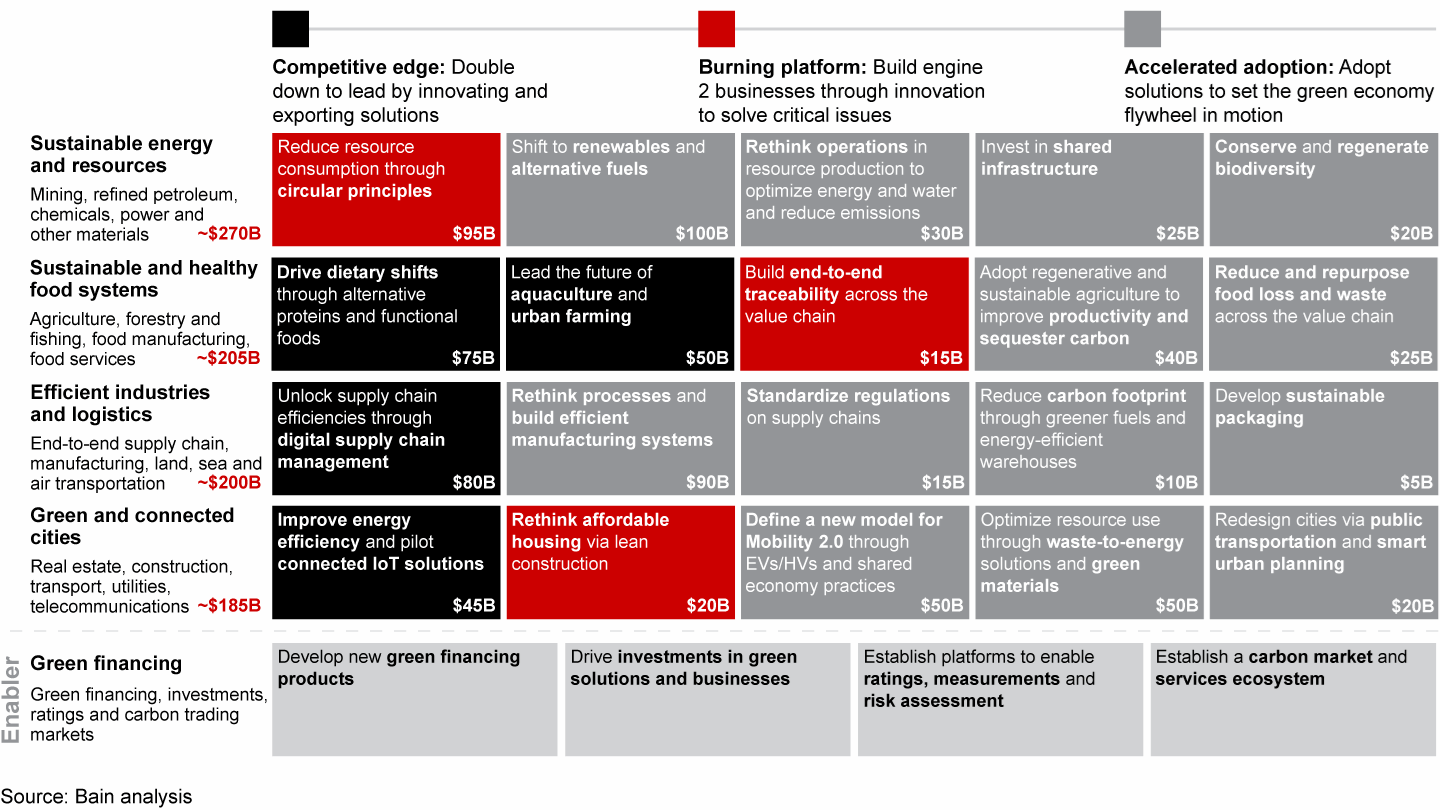
Sustainable energy and resources
Shifting to sustainable energy consumption and resource extraction presents $270 billion in annual economic opportunities by 2030. These opportunities include:
- Shifting to renewables and alternative fuels. Companies can take bold actions to rebalance portfolios by doubling down on low-carbon investments such as renewable energy sources. Gas will also remain key as a complementary transition fuel.
- Rethinking operations. Electrification of offshore assets is a significant opportunity as companies seek to reduce emissions and improve efficiencies in upstream operations. Oil and gas and mining companies can also increase efficiencies, improve worker safety and monitor emissions through remote monitoring systems and automation.
- Adopting circular economy practices. It is vital to design business models that reduce, restore and regenerate resources. Waste can be transformed into value-creating elements to lower costs and attain alternative revenue streams.
Other key pathways include conserving and regenerating biodiversity, as well as the sharing of resource-related infrastructure between mining and extraction companies and the public sector. Southeast Asia’s resource sector must find a more sustainable way to locate and harvest resources or face the prospect of stranded assets and reserves that will never be developed.
Sustainable and healthy food systems
Embarking on transformational pathways in the food and agriculture sector will allow companies in Southeast Asia to capture $205 billion in opportunities annually by 2030 and enable the region to produce nutritious food more sustainably. Opportunities include:
- Encouraging dietary shifts through alternative proteins and functional foods. With growing interest in healthier, more sustainable diets, businesses can invest early in new technologies such as alternative proteins. There are also opportunities to provide affordable and nutritious food such as fortified rice and low-sugar products.
- Leading the future of urban agriculture and sustainable aquaculture. Localizing production and increasing yield are key to feeding a growing urban population. Businesses can venture into urban agriculture practices such as vertical and indoor farming, while tapping into technologies that can increase yield and nutritional values. As a significant aquaculture producer, Southeast Asia can improve feed technologies and intensive aquaculture systems to boost yield.
- Building end-to-end traceability. Improving trust across the value chain is an immense challenge, yet this presents an enormous opportunity for companies to pursue. Digitally enabled solutions can provide visibility by monitoring suppliers’ practices while enabling regulators and consumers to trace products back to their origins. Companies are already active; for instance, Olam launched AtSource, a comprehensive sourcing solution that provides supply chain information, measures impact and supports transformation.
Other pathways crucial for a full transformation include the adoption of regenerative and sustainable agriculture to improve productivity, sequester carbon, reduce food loss and repurpose waste across the value chain.
Efficient industries and logistics
Establishing efficient industries and logistics offers a $200 billion opportunity by 2030. Opportunities in this sector include:
- Digitizing supply chains. Businesses can tap into digital solutions to track, trace and continuously monitor supply sources to solve supply chain performance issues in real time. Operations can be streamlined through optimizing fleet routes and managing inventory more efficiently with analytics and IoT solutions. In addition, automation can improve efficiency at warehouse operations and achieve more efficient overall use of energy.
- Standardizing regulations. Standardization of cross-border regulations is key to increase trade efficiencies, streamline logistics and cut costs. This includes coordination of trading activities, exchange of information and one-stop-shop trade portals and platforms.
- Reducing carbon footprints. With the bunkering and trucking industry’s quest for cleaner fuels, businesses can capture opportunities through the provision of liquefied natural gas (LNG) and hydrogen fuel. Companies can also use new technologies for greener and more efficient last-mile deliveries.
Other pathways include building efficient manufacturing systems by adopting industry 4.0 practices and developing sustainable packaging.
Green and connected cities
Transforming urban centers into green and connected cities offers $185 billion in opportunities by 2030. Opportunities include:
- Improving energy efficiency and connectivity. Businesses can unlock cost savings by installing efficient fixtures such as lights, HVAC, pumps and windows. In addition, Internet of Things (IoT) systems can enhance the development of a connected city.
- Rethinking affordable housing. With increasing housing requirements, companies need to find ways to reduce resources, costs and time. Modular technologies can construct housing options quickly at scale.
- Defining a new model for mobility 2.0. In addition to promoting shared urban mobility services, electric vehicles could be a catalyst for a mobility revolution in Southeast Asia.
Other pathways include the integration of waste management solutions and redesigning cities using smart urban planning. With an estimated 90 million people moving to Southeast Asian cities by 2030, the potential is immense.
Green financing
Green financing is an important enabler to support the growth and spark the transformation of the green economy. Financial institutions, investors and other service providers can pursue the following opportunities:
- Accelerating the shift to sustainable investing. Investors can deploy capital to projects or start-ups that support the growth of a green economy. With studies showing that funds incorporating ESG goals into their strategies perform as well as or better than other portfolios, investors can double down on efforts to incorporate sustainability criteria into investment decisions. For example, Singapore’s sovereign investor, Temasek, has pledged to reduce pollution and waste at portfolio firms and halve carbon emissions across the entire group by 2030.
- Developing green financing instruments. Taking advantage of products such as green loans or bonds, or risk mitigation tools such as green guarantees and insurances, will be key to fueling the growth of the green economy.
- Establishing a carbon market and services ecosystem. Carbon-related businesses such as low-carbon project development, consulting and verification services for clean development mechanisms, and carbon footprinting are emerging opportunities companies can tap into.
In addition, as investors’ expectations of sustainability rise, measurements and risk assessments will be important tools companies need to employ to ensure they have access to capital. Opportunities in the financing sector will grow in tandem with the rise of the green economy.
Time for a new perspective
Those who aspire to leadership in the green transformation must reframe their perspective on sustainability or risk playing catch-up. Southeast Asian business leaders can take four decisive actions on sustainability as the region moves forward.
- Pivot toward a system that sustainably reduces emissions and decarbonizes.
- Adopt regenerative and restorative business models for a circular economy.
- Protect, manage and restore natural ecosystems to preserve biodiversity.
- Foster social and organizational inclusivity by upskilling workers and communities.
CEOs should undertake the following measures to take advantage of the opportunities offered by the region’s growing green economy:
Adopt an investor’s perspective on their business and portfolio. Investor expectations are rising faster than businesses’ ability to adapt. Understanding this perspective is critical for anticipating where capital will flow, how risks will be valued and what effect regulation will have. This will require all businesses to measure their current footprint, which includes suppliers’ and customers’ activities, and set goals for the company’s sustainability journey.
Objectively measure the business’s sustainability full potential. To move in a sustainable direction, green economy solutions must be staged appropriately. Anticipating how cost–benefit trade-offs will evolve is key. For some, an optimal solution might be near-term bets on carbon offsets while working out long-term solutions to decarbonize operations.
Acknowledge that tomorrow will be different from today—and promote innovation. Leaders must recognize that certain business models may struggle to survive in the future, and they must add new drivers of growth to portfolios. Businesses that meet new consumer needs and the demands of the green economy will thrive. Staying relevant will require rethinking portfolios and making fundamental choices about likely futures while fostering innovation for sustainability.
Improve efficiency through operations and supply chains. A carbon problem is often an energy problem; waste is often a function of inefficiencies in operations. Inefficient or opaque supply chains expose companies to elevated cost and risk. Addressing these issues can have immediate impact on P&L. Future winners are likely to take a full view of their supply chains, integrating with a network of collaborators to achieve transparent, collaborative end-to-end transformation.
Inspire a new culture. Transformations, especially on new frontiers, happen not in boardrooms but at the front lines. Embedding sustainability needs CEO- and board-level leadership yet demands a cultural shift across all levels of the organization. A few targets, reports and metrics in themselves will not move the needle.
Form partnerships and alliances to transform your business and industry. Outcomes at scale need synchronized activity. Businesses, through partnerships and alliances, will need to align on industry-wide problems, define collective standards, push for regulations and educate suppliers as much as their customers and consumers. These measures will help to avoid duplication of effort while moving solutions to scale.
Southeast Asia’s journey toward a more sustainable future has begun. The question now is what the rewards will be and who will secure them. If Southeast Asia’s current and future corporate leaders are bold and forward-looking, material opportunities can be captured at home and abroad.

Southeast Asia’s Green Economy Potential
Bain's Gerry Mattios and Dale Hardcastle join Josh Henretig of Higg Co to discuss Southeast Asia's opportunity to lead the way to a greener 2030.